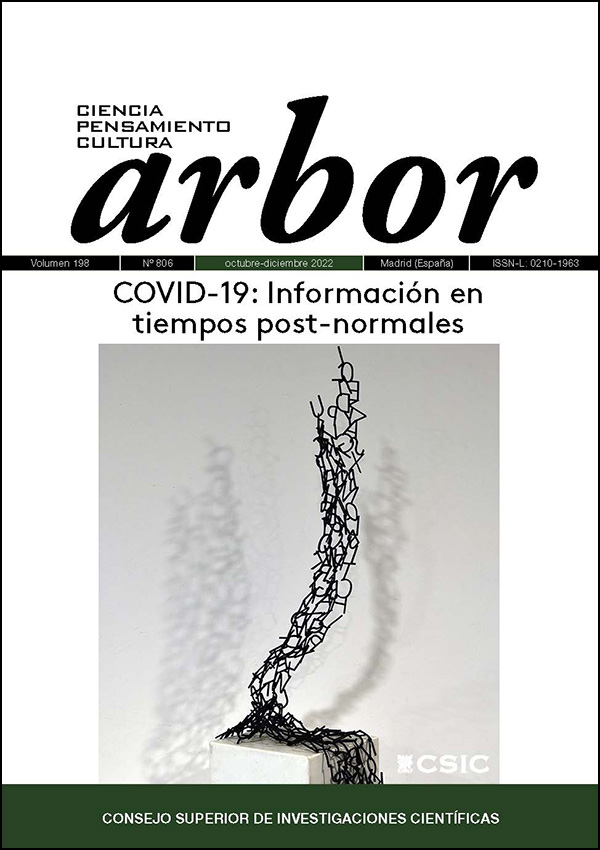Pandemias e infodemias: desinformación en tiempos postnormales
DOI:
https://doi.org/10.3989/arbor.2022.806001Descargas
Citas
Aghababaeian, Hamidreza, Hamdanieha, Lara y Ostadtaghizadeha Abbas (2020). Alcohol intake in an attempt to fight COVID-19: A medical myth in Iran. Alcohol, 88, 29-32. https://doi.org/10.1016/j.alcohol.2020.07.006 PMid:32693023 PMCid:PMC7368655
Ajzen, Icek (2012). The theory of planned behavior. En Paul A.M. Lange, Arie W. Kruglanski y E.Tory Higgins (eds.) Handbook of Theories of Social Psychology (pp. 438-459). London: SAGE. https://doi.org/10.4135/9781446249215.n22
Bauer, Martin W.; Allum, Nick y Miller, Steve (2007). What can we learn from 25 years of PUS survey research? Liberating and expanding the agenda. Public Understanding of Science, 16, 79-95. https://doi.org/10.1177/0963662506071287
Bauer, Martin, W.; Pangsegrau, Petra y Shukla, Rajesh (2019). The Cultural Authority of Science. Comparing across Europe, Asia, Africa and the Americas. Routledge. https://doi.org/10.4324/9781315163284
Bucchi, Massimiano (2008). Of deficits, deviations and dialogues. Theories of public communication of science. En Massimiano Bucchi y Brian Trench (eds.), Handbook of Public Communication of Science and Technology (pp.57-76). London-New York: Routledge.
Comisión Europea (2000). Commission adopts Communication on Precautionary Principle. IP/00/96. Bruselas, 2 de febrero de 2000. https://ec.europa.eu/commission/presscorner/detail/en/IP_00_96
Cialdini, Robert B. (1984). Influence: The Psychology of Persuasion. Nueva York: William Morroy e Company.
Cinelli, Mateo; Morales, Gianmarco de Francisci; Galeazzi, Alessandro; Quattrociocchi, Walter y Starnini, Michele (2021). The echo chamber effect on social media. PNAS, 111 (9). https://doi.org/10.1073/pnas.2023301118 PMid:33622786 PMCid:PMC7936330
Echeverría, Javier y Almendros, Lola (2020). Tecnopersonas. Cómo las tecnologías nos transforman. España: Trea.
Funtowicz, Silvio e Hidalgo, Cecilia (2021). Pandemia posnormal: las múltiples voces del conocimiento. Papeles de relaciones ecosociales y cambio global¸154, 109-122.
Funtowicz, Silvio y Ravetz, Jerome (1993). Science for the post-normal age. Futures, 31(7), 735-755. https://doi.org/10.1016/0016-3287(93)90022-L
Functowicz, Silvio, y Strand, Roger (2007). De la demostración experta al diálogo participativo. Revista CTS, 8(3), 97-113.
Godin, Benoit y Gingras, Yves (2000). What is scientific and technological culture and how is it measured? A multidimensional model. Public Understanding of Science, 9, 43-58. https://doi.org/10.1088/0963-6625/9/1/303
Gould, George Milbry y Pyle, Walter Lytle (1896). Anomalies and Curiosities of Medicine. Blacksleet River.. Proyecto Gutenberg. https://www.gutenberg.org/ebooks/747
Kahan, Dan M. (2012a). On the sources of Ordinary Science Knowledge and extraordinary Science Ignorance. En Kathleen H. Jamieson, Dan M. Kahan y Dietram A. Scheufele (eds.), (pp. 34-49) The Oxford Handbook of the Science on Science Communication. London-New York: Oxford University Press.
Kahan Dan M. (2012b). Cultural Cognition as a Conception of the Cultural Theory of Risk. En Sabine Roeser, Rafaela Hillerbrand, Per Sandin y Martin Peterson M (eds.), (pp. 725-759) Handbook of Risk Theory. Springer: Dordrecht. https://doi.org/10.1007/978-94-007-1433-5_28
Kahan, Dan M. (2017). Ordinary science intelligence': a science-comprehension measure for study of risk and science communication, with notes on evolution and climate change. Journal of Risk Research, 20(8), 995-1016. https://doi.org/10.1080/13669877.2016.1148067
Kahan, Dan M.; Peters, Ellen; Wittlin, Maggie; Slovic, Paul; Larrimore, Lisa; Braman, Donald y Mandel, Gregory (2012). The polarizing impact of science literacy and numeracy on perceived climate change risks. Nature Climate Change, 2, 732-735. https://doi.org/10.1038/nclimate1547
Kuhn, Thomas S. (1962). The Structure of Scientific Revolution. EEUU: University of Chicago Press.
López Cerezo, José Antonio (2018). La confianza en la sociedad del riesgo. Barcelona: Sello Editorial.
Miller, Jon D. (1983). Scientific Literacy: A Conceptual and Empirical Review. Daedalus, 112(2), 29-48. https://www.jstor.org/stable/pdf/20024852
Miller, Jon D. (1998). The measurement of civic scientific lireacy. Public Understanding of Science, 1(3), 203-223. https://doi.org/10.1088/0963-6625/7/3/001
Nickerson, Raymond S. (1998). Confirmation bias: A ubiquitous phenomenon in many guises. Review of General Psychology, 2(2), 175-220. https://doi.org/10.1037/1089-2680.2.2.175
Noelle-Neumann, Elisabeth (1974). The Spiral of Silence A Theory of Public Opinion. Journal of Communication, 24(2), 43-51. https://doi.org/10.1111/j.1460-2466.1974.tb00367.x
OMS, (2013). Pandemic Influenza Risk Management WHO Interim Guidance. World Health Organization. https://www.who.int/influenza/preparedness/pandemic/GIP_PandemicInfluenzaRiskManagementInterimGuidance_Jun2013.pdf.
Plous, Scott (1993). The psychology of judgment and decision making. EEUU: McGraw-Hill. https://doi.org/10.1037/e412982005-012
Scheufele, Dietram, A. y Moy, Patricia (2000). Twenty-five years of the spiral of silence: A conceptual review and empirical outlook. International Journal of Public Opinion Research, 12(1), 3-28. https://doi.org/10.1093/ijpor/12.1.3
Publicado
Cómo citar
Número
Sección
Licencia
Derechos de autor 2023 Consejo Superior de Investigaciones Científicas (CSIC)

Esta obra está bajo una licencia internacional Creative Commons Atribución 4.0.
© CSIC. Los originales publicados en las ediciones impresa y electrónica de esta Revista son propiedad del Consejo Superior de Investigaciones Científicas, siendo necesario citar la procedencia en cualquier reproducción parcial o total.
Salvo indicación contraria, todos los contenidos de la edición electrónica se distribuyen bajo una licencia de uso y distribución “Creative Commons Reconocimiento 4.0 Internacional ” (CC BY 4.0). Consulte la versión informativa y el texto legal de la licencia. Esta circunstancia ha de hacerse constar expresamente de esta forma cuando sea necesario.
No se autoriza el depósito en repositorios, páginas web personales o similares de cualquier otra versión distinta a la publicada por el editor.














